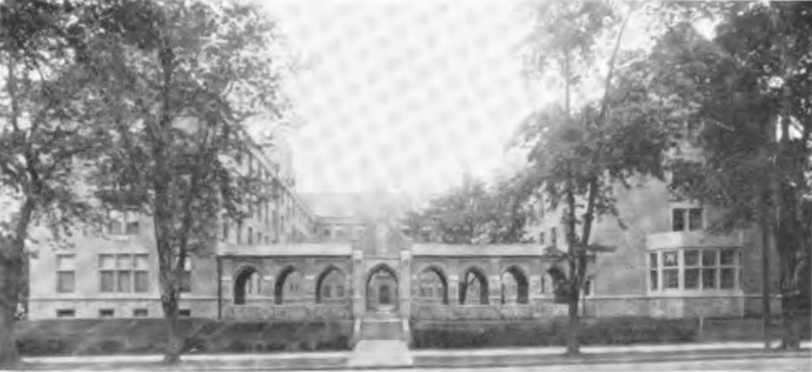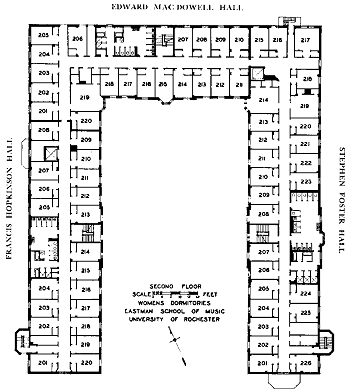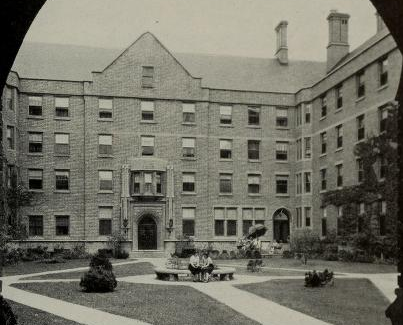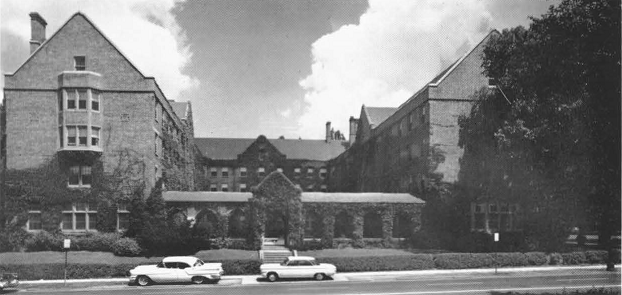
| Prince Street Campus | Women's Dormitories |
 |
| Women's Dormitory Group, from Rochester, the making of a university, by Jesse Leonard Rosenberger (1927), Page 222. |
 |
 |
 |
| General Floor Plan, Dormitories for Women, from Bulletin on Dormitories for Women, Eastman School of Music (1948) | Eastman Dormitory, from The Eastman School of Music: Its First Quarter Century, 1921-1946, by Charles Riker | Eastman Dormitory from The Eastman School of Music, 1947-1962: A Sequel, by Charles Riker, page 45. |
The Eastman School of Music attracted a large number of out-of-town women, who scrambled to find suitable lodgings. The school decided to build a new dormitory for women on land west of Prince Street, and the first of three units opened in 1925. These were named after Francis Hopkinson, the first American-born composer of distinction, Edward A. MacDowell, ranked at the top of American composers, and Stephen C. Foster, author of sentimental ballads and popular melodies like "My Old Kentucky Home." A 1948 publication includes the building layout plan (shown above) and the names of each wing.
The Eastman School and Women's College shared these dorms over the years.
After the new Eastman
Commons Student Living Center opened in 1991, these dormitories and
the adjacent Munro Hall (built in 1939) were sold
to the city in 1991 and became part of the relocated School
of the Arts.
References
1924 "Work to Open on
Woman's College Units in Spring," Democrat and Chronicle,
August 28, 1924, Page 21.
1925 "New Women's Dormitory at University," Democrat and Chronicle, June 11, 1925, Page 20.
1925 "Eastman
School of Music Has Largest Class in Its History; Notable Additions to
Faculty," Democrat and Chronicle, September 9, 1925, Page
17. | Part 2 |
The new women's dormitories in University avenue, to be opened next week,
have no vacant rooms left and it will be necessary for the Eastman School
of Music to operate No. 47 Prince street as an additional dormitory.
1925 "Women
of Arts College to Have Additional Room," The Campus,
October 30, 1925, Page 7.
42 Prince Street house turned over to Administration; add to new dorm.
1925 "Building of Additional Unit to Women's Dormitories is started; three structures to provide accommodations for 210 girls," The Campus, November 4, 1925, Page 4.
1925 "Third Wing Will be Added to New Dormitory Soon," The Campus, November 25, 1925, Page 1. | Part 2 |
1926 "Students from 37 states occupying Eastman dorm," The Campus, October 1, 1926, Page 3.
1927 Rochester,
the making of a university, by Jesse Leonard Rosenberger,
Pages 311-312: In 1924—26 the Eastman School of Music erected, on
property west of the President’s House and across University Avenue from
Anthony Memorial Hall, a dormitory group the architecture of which it has
been declared "gratifies the critical." The three connected units of the
group will accommodate 210 women students.
1948 Bulletin on Dormitories for Women, Eastman School of Music
1977 History
of the University of Rochester, by Arthur J. May (on-line
version with footnotes)
Chapter 19, Voices of Music
Before the School opened for instruction, the wife of Director
Klingenberg, The Notebook tells us, scurried about Rochester to
find lodgings for out-of-town students. Some women were quartered in the
abandoned home of the Institute of Musical Art, or in a dwelling on the
edge of the Prince Street Campus, and for a year two sororities, as noted,
had their own houses on the northern end of Oxford Street.
Growing numbers from outside of Rochester made better residence facilities
an urgent necessity. Consequently, the decision was taken in 1924 by the
University trustees to erect two dormitories on a tract of University
property west of the Rhees residence, whose architectural style would
harmonize in a measure with the Women's College complex across University
Avenue. Each unit would provide living quarters for sixty residents, with
twenty places set aside for undergraduates at the Women's College. Before
the first occupants moved in (1925), the trustees authorized a third
section, with rooms for eighty-seven students, giving the whole gray brick
and stone structure a U-shaped appearance; plans for two more units were
never carried out. House mothers of "culture and experience" were
appointed and residents set up a self-governing Student Council, charged
with defining and enforcing dormitory rules. For an academic year, room
rental was fixed at $180 and meals at $264.
Names for the three wings of the residential, center provoked a spate of
wrangling and debate in U. of R. circles. Eastman wanted "musicians of
established preeminence" honored, while Hanson stoutly insisted that only
American composers should be commemorated and in the end he won through.
Remembered were Francis Hopkinson, the first American-born composer of
distinction, Edward A. MacDowell, ranked at the top of American composers,
and Stephen C. Foster, author of sentimental ballads and popular melodies
like "My Old Kentucky Home."
1990 "Council
OKs site of school," Democrat and Chronicle, July 7, 1990,
Page 1B. | Part 2.
|
School of the Arts to move to Eastman dormitory.
© 2021 Morris A. Pierce